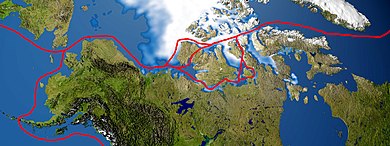

The Northwest Passage (NWP) is the sea lane between the Atlantic and Pacific oceans through the Arctic Ocean, along the northern coast of North America via waterways through the Arctic Archipelago of Canada.[1][2][3][4] The eastern route along the Arctic coasts of Norway and Siberia is accordingly called the Northeast Passage (NEP). The various islands of the archipelago are separated from one another and from Mainland Canada by a series of Arctic waterways collectively known as the Northwest Passages, Northwestern Passages[5] or the Canadian Internal Waters.
For centuries, European explorers, beginning with Christopher Columbus in 1492, sought a navigable passage as a possible trade route to Asia, but were blocked by North, Central, and South America, by ice, or by rough waters (e.g. Tierra del Fuego). An ice-bound northern route was discovered in 1850 by the Irish explorer Robert McClure whose expedition completed the passage by hauling sledges. Scotsman John Rae explored a more southerly area in 1854 through which Norwegian Roald Amundsen made the first complete passage entirely by ship in 1903–1906. Until 2009, the Arctic pack ice prevented regular marine shipping throughout most of the year. Arctic sea ice decline, linked primarily to climate change, has rendered the waterways more navigable for ice navigation.[6][7][8][9]
The contested sovereignty claims over the waters may complicate future shipping through the region: the Canadian government maintains that the Northwestern Passages are part of Canadian Internal Waters,[10] but the United States claims that they are an international strait and transit passage, allowing free and unencumbered passage.[11][12] If, as the head of a Canadian mining company claims, parts of the eastern end of the Passage are barely 15 metres (49 ft) deep,[13] the route's viability as a Euro-Asian shipping route is reduced. In 2016, Chinese shipping line COSCO expressed a desire to make regular voyages of cargo ships using the passage to the Eastern United States and Europe, after a successful passage by Nordic Orion of 73,500 tonnes deadweight tonnage in September 2013.[14][15][needs update] Fully laden, Nordic Orion sat too deep in the water to sail through the Panama Canal.
- ^ "Northwest passage". Merriam-Webster Online Dictionary. Archived from the original on September 12, 2018. Retrieved June 1, 2018.
- ^ Mitchell, Alanna (February 5, 2000). "The Northwest Passage Thawed". The Globe and Mail. p. A9. Archived from the original on July 30, 2007. Retrieved July 12, 2007.
- ^ Brigham, L.; McCalla, R.; Cunningham, E.; et al. (2009). Brigham, L.; Santos-Pedro, V.M.; Juurmaa, K. (eds.). Arctic Marine Shipping Assessment (PDF) (Report). Norway: Protection of the Arctic Marine Environment (PAME), Arctic Council. Archived from the original (PDF) on October 16, 2011.
- ^ Østreng, Willy; Eger, Karl Magnus; Fløistad, Brit; et al. (2013). Shipping in Arctic Waters: A Comparison of the Northeast, Northwest and Trans Polar Passages. Springer. doi:10.1007/978-3-642-16790-4. ISBN 978-3642167898. S2CID 41481012.
- ^ IHO Codes for Oceans & Seas, and Other Code Systems: IHO 23-3rd: Limits of Oceans and Seas, Special Publication 23 (3rd ed.). International Hydrographic Organization. 1953. Archived from the original on July 3, 2006. Retrieved July 28, 2007.
- ^ Cite error: The named reference
esawas invoked but never defined (see the help page). - ^ Cite error: The named reference
Beebwas invoked but never defined (see the help page). - ^ Cite error: The named reference
plainwas invoked but never defined (see the help page). - ^ Keating, Joshua E. (November 30, 2009). "The Top 10 Stories You Missed in 2009: A few ways the world changed while you weren't looking". Foreign Policy. Archived from the original on September 7, 2014. Retrieved March 10, 2017.
- ^ "TP 14202 E Interpretation". Transport Canada. Archived from the original on November 14, 2007.
- ^ Carnaghan, Matthew; Goody, Allison (January 26, 2006). Canadian Arctic Sovereignty (PDF) (Report). Library of Parliament. Archived from the original (PDF) on June 7, 2017. Retrieved June 1, 2018.
- ^ "Naval Operations in an ice-free Arctic" (PDF). Archived from the original (PDF) on October 5, 2011. Retrieved March 24, 2011.
- ^ "No to shipping ore through Northwest Passage – Baffinland CEO". Steel Guru. October 20, 2013. Archived from the original on October 21, 2013. Retrieved October 21, 2013.
The head of a Canadian mining company developing a massive mineral deposit within the Arctic Circle said the Northwest Passage won't work as a viable shipping route to Europe and Asia.
- ^ "China sets its sights on the Northwest Passage as a potential trade boon". The Guardian. April 20, 2016. Archived from the original on June 14, 2023. Retrieved August 8, 2016.
- ^ "China used research mission to test trade route through Canada's Northwest Passage". The Globe and Mail. September 10, 2017. Archived from the original on August 18, 2018. Retrieved August 20, 2019.